Abstract
Bacteriophage T7 early transcripts were used as carriers of alkylating groups to affect complementary T7 DNA sites for inducing mutations in preselected genes. A heterofunctional polyalkylating agent N,N,N'-tri-(beta-chloroethyl)-N'-(p-formylphenyl)propylene diamine-1,3 was attached to 3-5% of the transcript nucleotides. The controlled alkylating groups carried on RNA were activated after RNA . DNA hybridization. The modified transcripts were shown to hybridize only with the complementary H strand and to form covalently bound R loops in the appropriate T7 sites. The T7 DNA molecules locally alkylated by the modified transcripts of gene 1.3 coding for T7 ligase were packaged into T7 proteins and used to infect Escherichia coli B. As judged by plating efficiency and the ligase-deficient E. coli BL2 strain, 4 of 140 plaques obtained after infection contained mutants defective in gene 1.3 in amounts of 0.7-1.5%. The T7 DNA locally alkylated by the modified transcripts of gene 0.3 and 1.1 were used for the transfection of E. coli C1757. Analysis of 24 plaques produced by transfection indicated that 3 contained mutants defective in gene 0.3 in amounts of 2-10%. The mutants had also a second unidentified mutation. Complementation analysis data suggest that the second mutation is due to a defect in gene 1.1. The results obtained demonstrate the efficiency of the approach developed for gene-directed mutagenesis.
Full text
PDF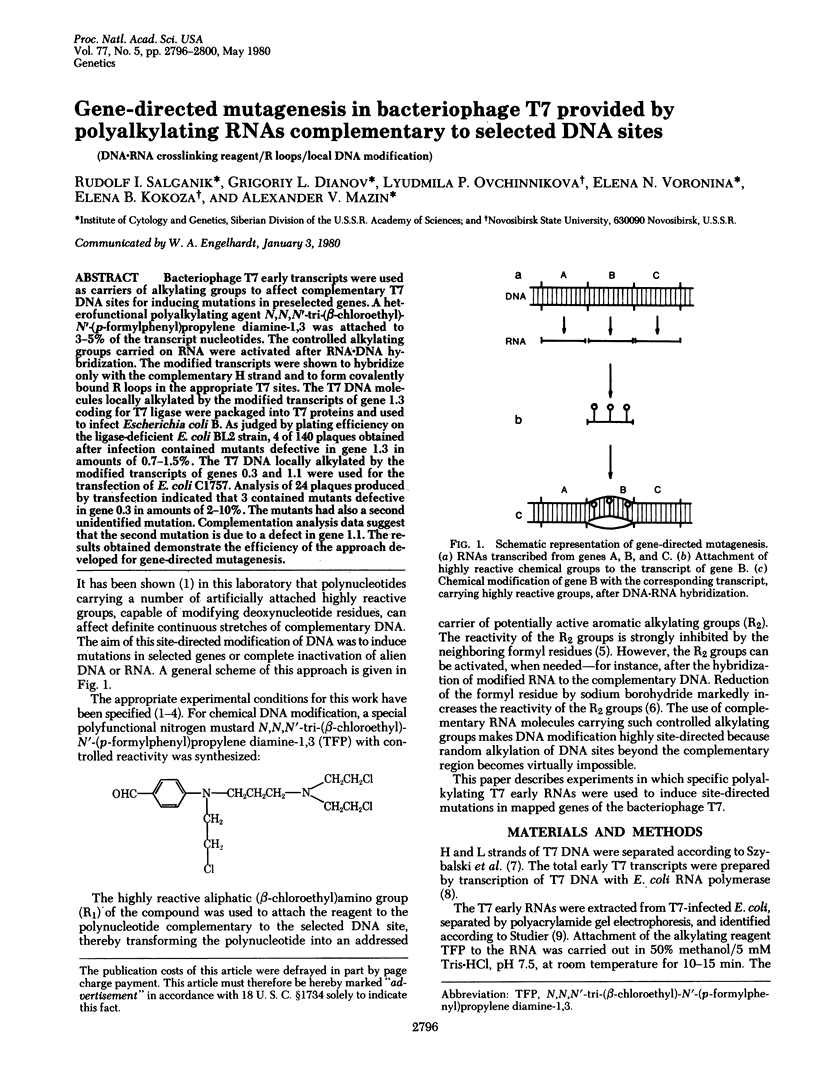
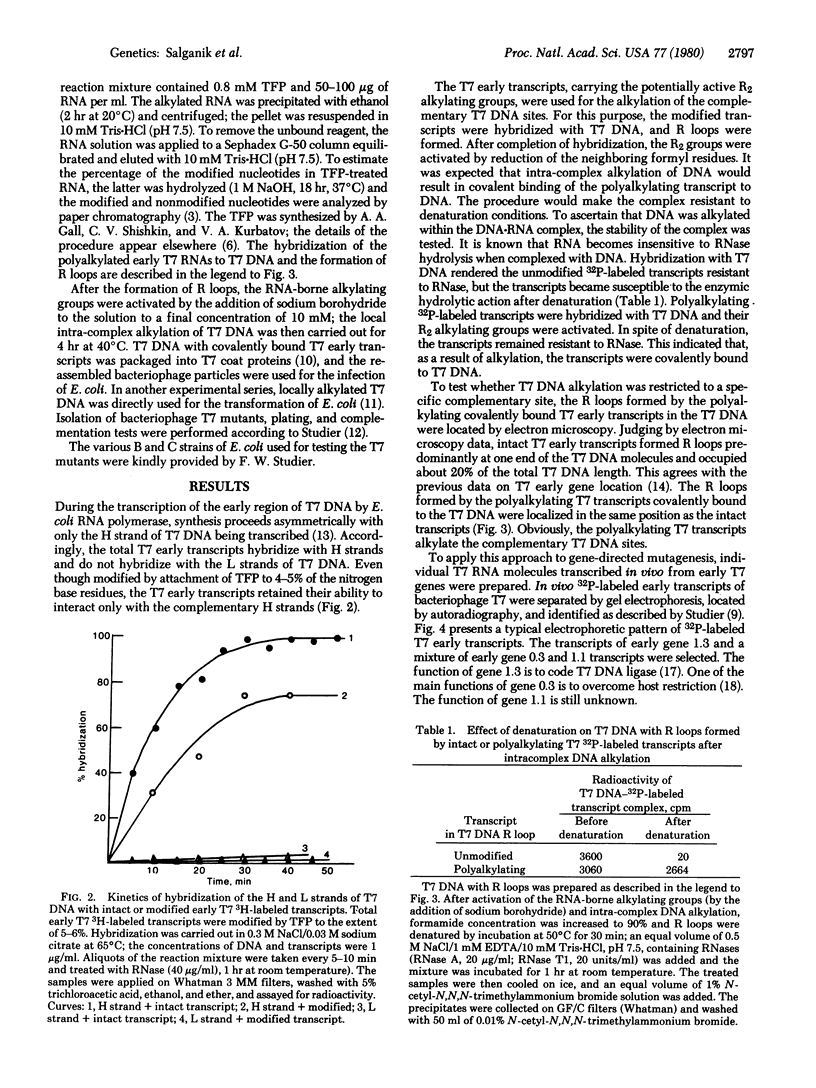
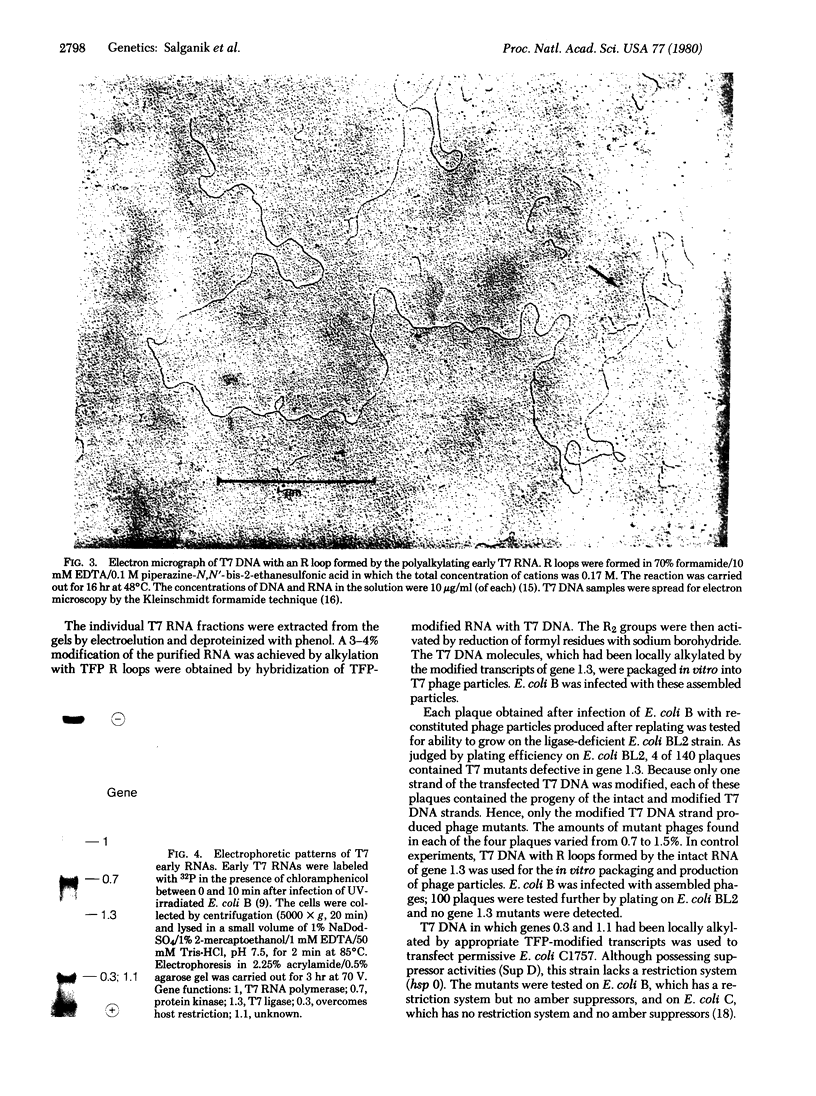
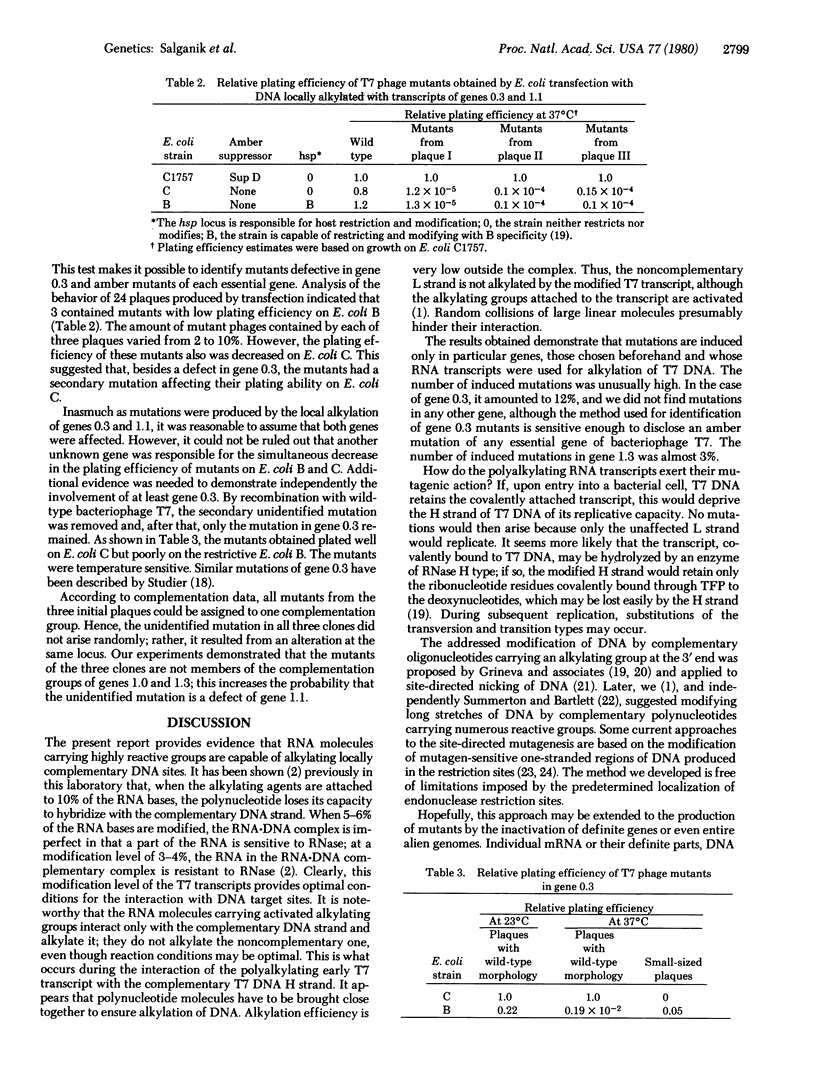
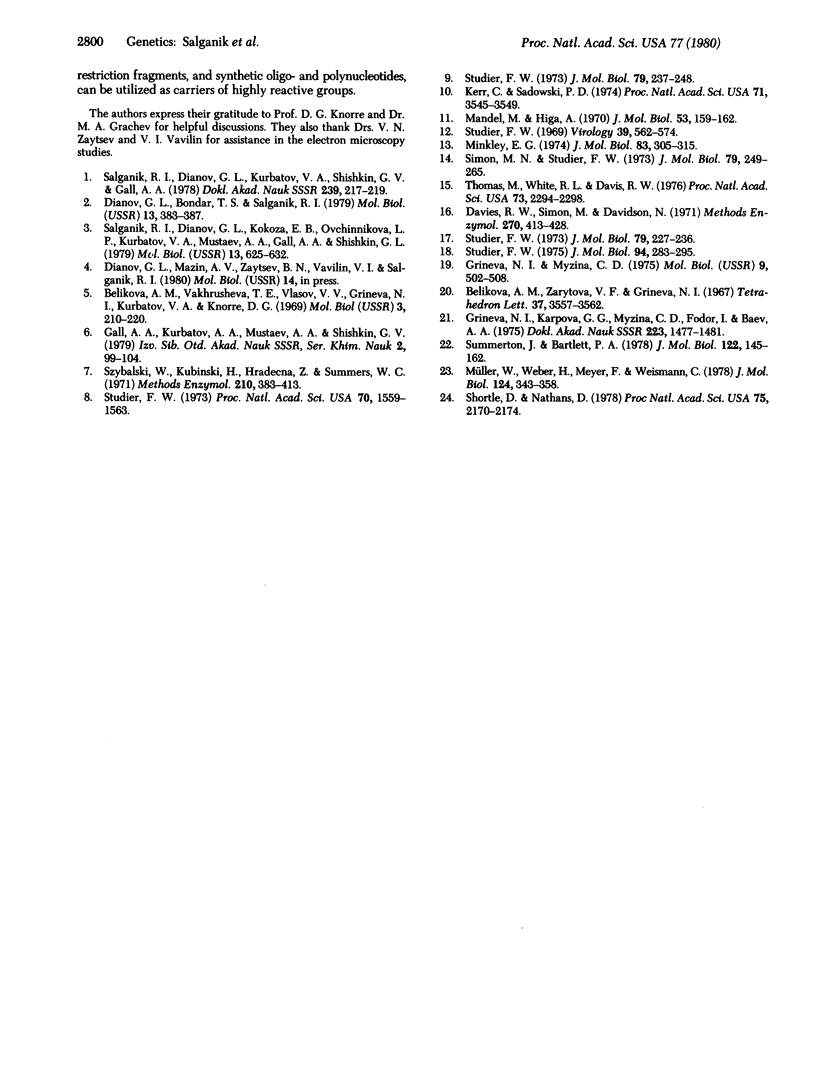
Images in this article
Selected References
These references are in PubMed. This may not be the complete list of references from this article.
- Belikova A. M., Zarytova V. F., Grineva N. I. Synthesis of ribonucleosides and diribonucleoside phosphates containing 2-chloroethylamine and nitrogen mustard residues. Tetrahedron Lett. 1967 Sep;37:3557–3562. doi: 10.1016/s0040-4039(01)89794-x. [DOI] [PubMed] [Google Scholar]
- Dianov G. L., Bondar' T. S., Salganik R. I. Issledovanie komplementarnogo vzaimodeistviia mnozhestvenno alkilirovannykh poliribonukleotidov. Mol Biol (Mosk) 1979 Mar-Apr;13(2):383–387. [PubMed] [Google Scholar]
- Dunn J. J., Studier F. W. T7 early RNAs are generated by site-specific cleavages. Proc Natl Acad Sci U S A. 1973 May;70(5):1559–1563. doi: 10.1073/pnas.70.5.1559. [DOI] [PMC free article] [PubMed] [Google Scholar]
- Grineva N. I., Karpova G. G., Myzina S. D., Fodor I., Baev A. A. Komplementarno adresovannaia fragmentatsiia DNK. Khimicheskoe modelirovanie fermentov restriktsii s rasshchepleniem DNK vblizi oligotimidilovykh posledovatel'nostei. Dokl Akad Nauk SSSR. 1975 Aug 21;223(6):1477–1480. [PubMed] [Google Scholar]
- Grineva N. I., Myzina S. D. Kineticheskie kharakteristiki alkilirovaniia DNK khloretilarilaminami i eliminatsii alkilirovannykh osnovanii iz DNK. Mol Biol (Mosk) 1975 Jul-Aug;9(4):502–508. [PubMed] [Google Scholar]
- Kerr C., Sadowski P. D. Packaging and maturation of DNA of bacteriophage T7 in vitro. Proc Natl Acad Sci U S A. 1974 Sep;71(9):3545–3549. doi: 10.1073/pnas.71.9.3545. [DOI] [PMC free article] [PubMed] [Google Scholar]
- Mandel M., Higa A. Calcium-dependent bacteriophage DNA infection. J Mol Biol. 1970 Oct 14;53(1):159–162. doi: 10.1016/0022-2836(70)90051-3. [DOI] [PubMed] [Google Scholar]
- Minkley E. G., Jr Transcription of the early region of bacteriophage T7: specificity and selectivity in the in vitro initiation of RNA synthesis. J Mol Biol. 1974 Mar;83(3):305–331. doi: 10.1016/0022-2836(74)90282-4. [DOI] [PubMed] [Google Scholar]
- Müller W., Weber H., Meyer F., Weissmann C. Site-directed mutagenesis in DNA: generation of point mutations in cloned beta globin complementary dna at the positions corresponding to amino acids 121 to 123. J Mol Biol. 1978 Sep 15;124(2):343–358. doi: 10.1016/0022-2836(78)90303-0. [DOI] [PubMed] [Google Scholar]
- Salganik R. I., Dianov G. L., Kokoza E. B., Ovchinnikova L. P., Kurbatov V. A. Napravlennaia modifikatsiia DNK bakteriofaga T7 v oblasti rannikh genov s pomoshch'iu komplementarnogo RNK-transkripta, nesushchego mnozhestvennye alkiliruiushchie gruppy. Mol Biol (Mosk) 1979 May-Jun;13(3):625–632. [PubMed] [Google Scholar]
- Salganik R. I., Dianov G. L., Kurbatov V. A., Shishkin G. V., Gall' A. A. Napravlennoe vozdeistvie na genom bakteriofaga T7 s pomoshch'iu transkripta oblasti rannikh genov, nesushchego mnozhestvennye alkiliruiushchie gruppy. Dokl Akad Nauk SSSR. 1978;239(1):217–219. [PubMed] [Google Scholar]
- Shortle D., Nathans D. Local mutagenesis: a method for generating viral mutants with base substitutions in preselected regions of the viral genome. Proc Natl Acad Sci U S A. 1978 May;75(5):2170–2174. doi: 10.1073/pnas.75.5.2170. [DOI] [PMC free article] [PubMed] [Google Scholar]
- Simon M. N., Studier F. W. Physical mapping of the early region of bacteriophage T7 DNA. J Mol Biol. 1973 Sep 15;79(2):249–265. doi: 10.1016/0022-2836(73)90004-1. [DOI] [PubMed] [Google Scholar]
- Studier F. W. Analysis of bacteriophage T7 early RNAs and proteins on slab gels. J Mol Biol. 1973 Sep 15;79(2):237–248. doi: 10.1016/0022-2836(73)90003-x. [DOI] [PubMed] [Google Scholar]
- Studier F. W. Gene 0.3 of bacteriophage T7 acts to overcome the DNA restriction system of the host. J Mol Biol. 1975 May 15;94(2):283–295. doi: 10.1016/0022-2836(75)90083-2. [DOI] [PubMed] [Google Scholar]
- Studier F. W. Genetic analysis of non-essential bacteriophage T7 genes. J Mol Biol. 1973 Sep 15;79(2):227–236. doi: 10.1016/0022-2836(73)90002-8. [DOI] [PubMed] [Google Scholar]
- Studier F. W. The genetics and physiology of bacteriophage T7. Virology. 1969 Nov;39(3):562–574. doi: 10.1016/0042-6822(69)90104-4. [DOI] [PubMed] [Google Scholar]
- Summerton J., Bartlett P. A. Sequence-specific crosslinking agents for nucleic acids. Use of 6-bromo-5,5-dimethoxyhexanohydrazide for crosslinking cytidine to guanosine and crosslinking RNA to complementary sequences of DNA. J Mol Biol. 1978 Jun 25;122(2):145–162. doi: 10.1016/0022-2836(78)90032-3. [DOI] [PubMed] [Google Scholar]
- Thomas M., White R. L., Davis R. W. Hybridization of RNA to double-stranded DNA: formation of R-loops. Proc Natl Acad Sci U S A. 1976 Jul;73(7):2294–2298. doi: 10.1073/pnas.73.7.2294. [DOI] [PMC free article] [PubMed] [Google Scholar]




